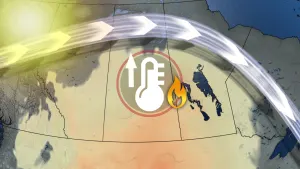
Watch your plate: Foodborne illness to rise as world warms
Keeping our food safe to eat will be more challenging as climate change progresses.
The Public Health Agency of Canada has released a new study confirming that climate change may bring some internal complications for Canadians.
The study claimed to find many links of an increased risk of microbial foodborne diseases as the climate changes.
The way we grow crops, produce livestock and pull from the oceans will all be impacted with a warming globe. Climate change has also tweaked precipitation patterns which has a large impact on the production of food.
The study highlighted the following illnesses that should be monitored as climate change unfolds:
Norovirus
Clostridium Perfrigens
Campylobacter spp.
Salmonella
Bacillus Cereus
Verotoxigenic Escherichia Coli
Toxoplasma Gondii
Vibrio Parahaemolyticus
Listeria Monocytogenes
Vibrio Vulnificus

Salmonella is one of several common foodborne illnesses that could become more common as the world warms. Image: Nathan Reading/Wikimedia Commons.
Dr. Renee Salas, who works in the Department of Emergency Medicine at the Massachusetts General Hospital, told The Weather Network that illnesses like vibrio will likely become more of a concern in seafood, spreading faster as the air and oceans warm. She gave the example of an oyster -- that with warmer water, air vibrio will spread faster and will become more common on seafood.
The pathogen vibrio will form on seafood when it’s still in the water. People may experience vibriosis if the seafood they eat is contaminated and then not cooked properly. It is a foodborne illness that affects the intestines and results in diarrhea, stomach cramping and vomiting. Some cases can become severe and have a fatal outcome.
When it comes to the weather, the following have the highest potential to influence the increase of illness:
Increase in extreme events
Increase in air and water temperatures
Changes to precipitation intensity/frequency
The study also makes the connection between E. Coli and livestock: As temperatures warm the climate becomes more stressful for livestock, they may sweat, expel bodily fluids and pass along illness to others.
Diseases can spread quickly among livestock, especially enteric pathogens which enter the body through the mouth. Infected animal feces could be a catalyst when it comes to the spread of these microbial diseases.
The survival of E Coli is linked to temperature, moisture, and interactions within the microbial community.
These illnesses caused by food have many complications for humans. The World Health Organization released a report estimating worldwide foodborne illness caused 600 million cases of sickness and 420,000 deaths in 2010.
If we look at just Canada from 2000 to 2010, there were four million cases of foodborne disease.
These new connections are creating an urge for medical professionals to stay informed on foodborne illness trends so we can better recognize and diagnose cases. Public health also needs to be well equipped to handle more cases.
Ultimately we are responsible for the safeguard of our food system. Knowing the risks and the connection between climate change and illness is the first step to creating a better environment.
WATCH BELOW: RESEARCH SHOWS CLIMATE CHANGE IMPACTS HUMAN HEALTH, HERE'S WHY
Sources: Public Health Agency of Canada | World Health Organization










